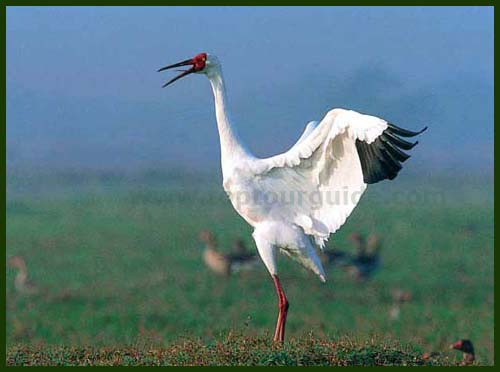Home :: Indian National Parks :: Keoladeo National Park
Keoladeo National Park
This former duck-hunting reserve of the Maharajas is one of the major wintering areas for great numbers of aquatic birds from Afghanistan, Turkmenistan, China and Siberia. Some Three Hundred and Sixty Four (364) species of birds, including the rare Siberian crane, have been recorded in the park.

The site is situated in eastern Rajasthan, the park is two (2) km south-east of Bharatpur and Fifty (50) km west of Agra. The area consists of a flat patchwork of marshes in the Gangetic plain, artificially shaped in the 1850s and maintained ever since by a system of canals, sluices and dykes normally, water is fed into the marshes two times in a year from inundations of the Gambira and Banganga rivers, which are impounded on arable land by means of an artificial dam called Ajan Bund, to the south of the park the first time, usually in mid-July month, is soon after the onset of the monsoon and the second time is in late September or October when Ajan Bund is drained ready for cultivation in winter thus, the area is flooded to a depth of 1-2 m throughout the monsoon (July-September), after which the water level drops from February onwards the land begins to dry out and by June only some water remains for much of the year the area of wetland is only one thousand ha. Soils are predominantly alluvial - some clay has formed as a result of the periodic inundations.

In a semi-arid biotype, the area is the only area with much vegetation, hence the term 'Ghana' meaning 'thicket' the primary vegetation types are tropical dry deciduous forest, intermixed with dry grassland in areas where forest has been degraded apart from the artificially managed marshes, much of the area is covered by medium-sized trees and shrubs forests, mostly in the north-east of the park, are dominated by kalam or kadam, jamun and babul. The open woodland is frequently babul with a small amount of kandi and ber. Scrublands are conquered by ber and kair. The aquatic vegetation is rich in species and is a valuable source of food for waterfowl primates are rhesus macaque and langur. Large predators are absent, leopard having been deliberately exterminated by 1964, but small carnivores include Bengal fox, jackal, striped hyena, common palm civet, small Indian civet, Indian grey mongoose Herpestes edwardsi , fishing cat, leopard cat, jungle cat and smooth-coated otter. Ungulates include blackbuck, chital, sambar, hog deer, nilgai and wild boar and feral cattle. Other mammals include Indian porcupine and Indian hare.
An estimated sixty million fish fry are carried into the park's water impoundments by river flooding every year during the monsoon season, which provides the food base for great numbers of wading and fish-eating birds.



